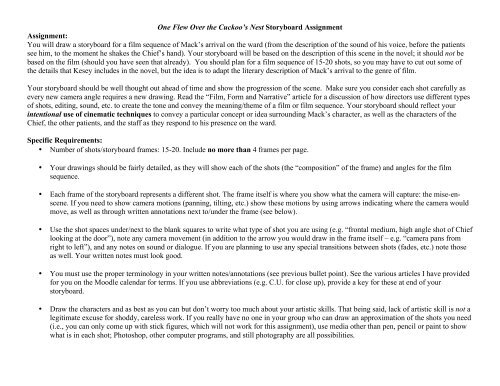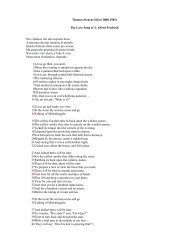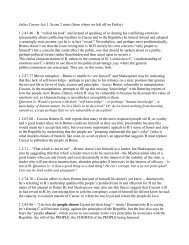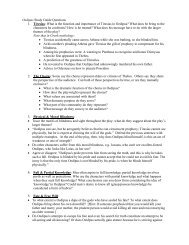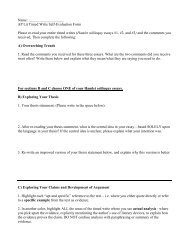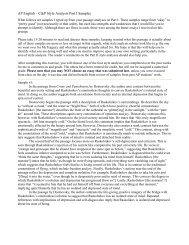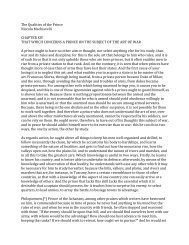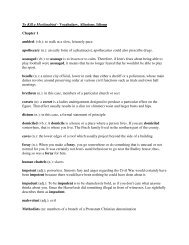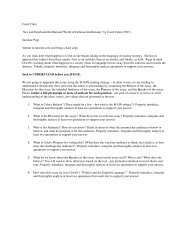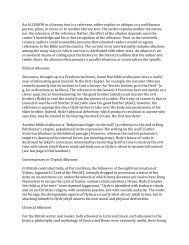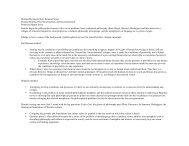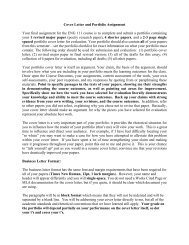One Flew Over the Cuckoo's Nest Storyboard Assignment ...
One Flew Over the Cuckoo's Nest Storyboard Assignment ...
One Flew Over the Cuckoo's Nest Storyboard Assignment ...
- No tags were found...
You also want an ePaper? Increase the reach of your titles
YUMPU automatically turns print PDFs into web optimized ePapers that Google loves.
<strong>One</strong> <strong>Flew</strong> <strong>Over</strong> <strong>the</strong> Cuckoo’s <strong>Nest</strong> <strong>Storyboard</strong> <strong>Assignment</strong><strong>Assignment</strong>:You will draw a storyboard for a film sequence of Mack’s arrival on <strong>the</strong> ward (from <strong>the</strong> description of <strong>the</strong> sound of his voice, before <strong>the</strong> patientssee him, to <strong>the</strong> moment he shakes <strong>the</strong> Chief’s hand). Your storyboard will be based on <strong>the</strong> description of this scene in <strong>the</strong> novel; it should not bebased on <strong>the</strong> film (should you have seen that already). You should plan for a film sequence of 15-20 shots, so you may have to cut out some of<strong>the</strong> details that Kesey includes in <strong>the</strong> novel, but <strong>the</strong> idea is to adapt <strong>the</strong> literary description of Mack’s arrival to <strong>the</strong> genre of film.Your storyboard should be well thought out ahead of time and show <strong>the</strong> progression of <strong>the</strong> scene. Make sure you consider each shot carefully asevery new camera angle requires a new drawing. Read <strong>the</strong> “Film, Form and Narrative” article for a discussion of how directors use different typesof shots, editing, sound, etc. to create <strong>the</strong> tone and convey <strong>the</strong> meaning/<strong>the</strong>me of a film or film sequence. Your storyboard should reflect yourintentional use of cinematic techniques to convey a particular concept or idea surrounding Mack’s character, as well as <strong>the</strong> characters of <strong>the</strong>Chief, <strong>the</strong> o<strong>the</strong>r patients, and <strong>the</strong> staff as <strong>the</strong>y respond to his presence on <strong>the</strong> ward.Specific Requirements:• Number of shots/storyboard frames: 15-20. Include no more than 4 frames per page.• Your drawings should be fairly detailed, as <strong>the</strong>y will show each of <strong>the</strong> shots (<strong>the</strong> “composition” of <strong>the</strong> frame) and angles for <strong>the</strong> filmsequence.• Each frame of <strong>the</strong> storyboard represents a different shot. The frame itself is where you show what <strong>the</strong> camera will capture: <strong>the</strong> mise-enscene.If you need to show camera motions (panning, tilting, etc.) show <strong>the</strong>se motions by using arrows indicating where <strong>the</strong> camera wouldmove, as well as through written annotations next to/under <strong>the</strong> frame (see below).• Use <strong>the</strong> shot spaces under/next to <strong>the</strong> blank squares to write what type of shot you are using (e.g. “frontal medium, high angle shot of Chieflooking at <strong>the</strong> door”), note any camera movement (in addition to <strong>the</strong> arrow you would draw in <strong>the</strong> frame itself – e.g. “camera pans fromright to left”), and any notes on sound or dialogue. If you are planning to use any special transitions between shots (fades, etc.) note thoseas well. Your written notes must look good.• You must use <strong>the</strong> proper terminology in your written notes/annotations (see previous bullet point). See <strong>the</strong> various articles I have providedfor you on <strong>the</strong> Moodle calendar for terms. If you use abbreviations (e.g. C.U. for close up), provide a key for <strong>the</strong>se at end of yourstoryboard.• Draw <strong>the</strong> characters and as best as you can but don’t worry too much about your artistic skills. That being said, lack of artistic skill is not alegitimate excuse for shoddy, careless work. If you really have no one in your group who can draw an approximation of <strong>the</strong> shots you need(i.e., you can only come up with stick figures, which will not work for this assignment), use media o<strong>the</strong>r than pen, pencil or paint to showwhat is in each shot; Photoshop, o<strong>the</strong>r computer programs, and still photography are all possibilities.
<strong>One</strong> <strong>Flew</strong> <strong>Over</strong> <strong>the</strong> Cuckoo’s <strong>Nest</strong> <strong>Storyboard</strong> <strong>Assignment</strong>Shot: ________________________________________________________________________________________________________________________________________________________________Shot: ________________________________________________________________________________________________________________________________________________________________Shot: ________________________________________________________________________________________________________________________________________________________________Shot: ________________________________________________________________________________________________________________________________________________________________


